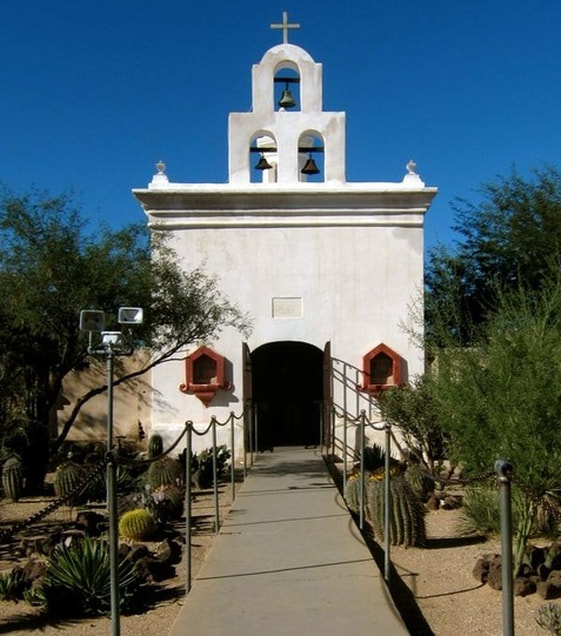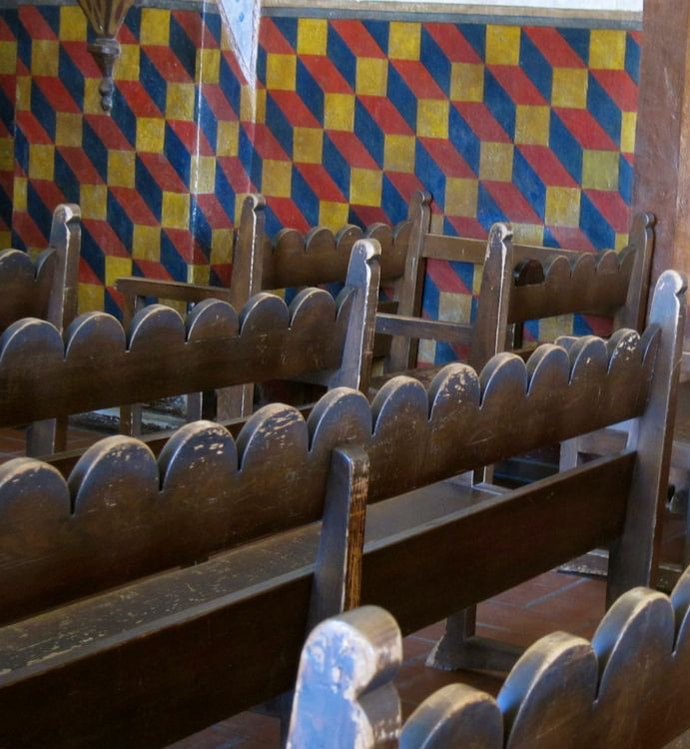San Xavier del Bac
San Xavier del Bac sits in the middle of the Sonora, surrounded by cactus, fractured rock and sand. It has almost no relationship with the land around it or the expectations of the visitor but it fits.
It sits proudly as a remnant of visitors from space that landed on this bleak landscape among the native Americans to bring in new and, in few cases, better ideas.
It sits proudly as a remnant of visitors from space that landed on this bleak landscape among the native Americans to bring in new and, in few cases, better ideas.
The Church is a memento of the Spanish influence on both Architecture and Religion in this southern Arizona region. It's a relic that's very much alive as the Community Church for Tohono O'odham.
Just to sit and look and try to understand the impact of this building on tent and adobe dwelling people is to begin to enter the awareness of the impact of its creation. Although not massive by European standards, its location in the Desert magnifies its size into a huge basilica. The perception becomes a reality. It is indeed The White Dove of the Desert.
San Xavier del Bac, located on the Tohono O'odham San Xavier Indian Reservation in Tucson, Arizona was for many years, the Jesuit Mission headquarters when Southern Arizona was part of Pimeria Alta of the Vice Royalty of New Spain. Founded by, Padre Eusebio Kino around 1692 in the then village of Wa:k, this Jesuit Missionary named it after the famous Jesuit Missionary who spread the Word of God as far as India and Malacca.
Missionaries usually consolidated villages and pacified the natives making them loyal subjects of the Spanish Royal Crown. Can you imagine the astonishment of these natives when they were told that the land of their ancestors and where they are free to roam and use its resources is owned by a King they haven't even heard of and live so far away? What a puzzle that must have been.
Missionaries usually consolidated villages and pacified the natives making them loyal subjects of the Spanish Royal Crown. Can you imagine the astonishment of these natives when they were told that the land of their ancestors and where they are free to roam and use its resources is owned by a King they haven't even heard of and live so far away? What a puzzle that must have been.
There were around 900 natives in Bac as counted by Juan Mateo Manje, the companion of Fr. Kino. Manje called the area the best mission site in the region, being close to the Santa Cruz River and at that time said to have had natural springs, observing that people are happy going about their day under the eyes of the missionary fathers.
The natives were then called Papagos of Piman stock. The missionaries described them as dull and with very small understanding.
They practiced plural marriage and indulged periodically in ritual drunkenness usually for 2 or 3 days after the cactus fruit ripened. Their ceremonials were magic, their story of the great flood and their myth of a saviour bordered believe it or not.
But paintings showed how the natives lived practicing agriculture, living close to Nature and tending to their animals. Nature has taught them many things on how to survive in the desert.
They practiced plural marriage and indulged periodically in ritual drunkenness usually for 2 or 3 days after the cactus fruit ripened. Their ceremonials were magic, their story of the great flood and their myth of a saviour bordered believe it or not.
But paintings showed how the natives lived practicing agriculture, living close to Nature and tending to their animals. Nature has taught them many things on how to survive in the desert.
In 1767, Charles III, the Spanish King at that time, having been influenced by reform minded advisers, expelled the Jesuits and sent the Franciscans.
The Jesuits then realistically thought that the attraction of the Mission was that there was always food and protection from other warring natives.
The Jesuits then realistically thought that the attraction of the Mission was that there was always food and protection from other warring natives.
This was no longer what the King wanted. He ordered that the Indians were no longer to be classed as servants, children or inferiors but independent tax paying subjects of the Spanish crown, on par with the Spanish settlers.
In 1768, a Franciscan called Father Francisco came to the mission. A country boy from Aragon, he proved himself the ideal choice for the mission. He liked people so he went among the Indians with just an interpreter, ate their food and sits with them around their fire and the Indians trusted him.
However, the Apaches raided constantly eventually destroying the Church started by Fr. Kino. But the significant role of this Mission in opening up routes and settlements in San Diego and other parts of California could not be discounted.
However, the Apaches raided constantly eventually destroying the Church started by Fr. Kino. But the significant role of this Mission in opening up routes and settlements in San Diego and other parts of California could not be discounted.
The current Church, the oldest European structure in Arizona and the finest example of Spanish colonial architecture in the United States, was constructed in 1783 and was completed in 1797.
It was started by Fr. Juan Bautista Velderrain who borrowed money from a Sonoran rancher and hired the architect, Ignacio Gaona to start construction. Gaona used low-fire fly brick, stone and lime mortar and roofed it with masonry vaults. He worked with local native American artisans.
It was, however, Fr. Juan Bautista Llorens in 1797 who completed the great church in San Xavier Del Bac begun by Father Velderrain.
It was, however, Fr. Juan Bautista Llorens in 1797 who completed the great church in San Xavier Del Bac begun by Father Velderrain.
Today, the moment you step inside San Xavier del Bac you are immediately transported to the 18th century. Some of its original statuaries and paintings tell the story of that time.
It is as if you've entered a Mexican Catholic Church especially with the Mother of Guadalupe occupying a place of honour. But also because most of the art work here are said to have been created by artists in Queretaro (then a part of New Spain, now of Mexico).
Below are some of the pictures of the interior of the Church.
It is as if you've entered a Mexican Catholic Church especially with the Mother of Guadalupe occupying a place of honour. But also because most of the art work here are said to have been created by artists in Queretaro (then a part of New Spain, now of Mexico).
Below are some of the pictures of the interior of the Church.
In the past, the Pulpit is where the priest delivers the Homily or Sermon. These days, this is no longer practiced.
The Museum has a video showing the history of the place.
There is enough parking. Easy to do a self-tour when there is no service going on in the Church.
The gardens are beautifully maintained. There is also a gift shop where you can buy crafts of the first nations and other religious items.
There is enough parking. Easy to do a self-tour when there is no service going on in the Church.
The gardens are beautifully maintained. There is also a gift shop where you can buy crafts of the first nations and other religious items.
To visit another interesting place in Arizona, click on this link:












